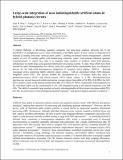Large-scale integration of artificial atoms in hybrid photonic circuits
Author(s)
Han, Noel H.; Lu, Tsung-Ju; Chen, Kevin C.; Walsh, Michael P.; Trusheim, Matthew E; De Santis, Lorenzo; Bersin, Eric Alexander; Harris, Isaac B.; Mouradian, Sara L; Christen, Ian R.; Englund, Dirk R.; ... Show more Show less
DownloadAccepted version (5.442Mb)
Publisher Policy
Publisher Policy
Article is made available in accordance with the publisher's policy and may be subject to US copyright law. Please refer to the publisher's site for terms of use.
Terms of use
Metadata
Show full item recordAbstract
A central challenge in developing quantum computers and long-range quantum networks is the distribution of entanglement across many individually controllable qubits1. Colour centres in diamond have emerged as leading solid-state ‘artificial atom’ qubits2,3 because they enable on-demand remote entanglement4, coherent control of over ten ancillae qubits with minute-long coherence times5 and memory-enhanced quantum communication6. A critical next step is to integrate large numbers of artificial atoms with photonic architectures to enable large-scale quantum information processing systems. So far, these efforts have been stymied by qubit inhomogeneities, low device yield and complex device requirements. Here we introduce a process for the high-yield heterogeneous integration of ‘quantum microchiplets’—diamond waveguide arrays containing highly coherent colour centres—on a photonic integrated circuit (PIC). We use this process to realize a 128-channel, defect-free array of germanium-vacancy and silicon-vacancy colour centres in an aluminium nitride PIC. Photoluminescence spectroscopy reveals long-term, stable and narrow average optical linewidths of 54 megahertz (146 megahertz) for germanium-vacancy (silicon-vacancy) emitters, close to the lifetime-limited linewidth of 32 megahertz (93 megahertz). We show that inhomogeneities of individual colour centre optical transitions can be compensated in situ by integrated tuning over 50 gigahertz without linewidth degradation. The ability to assemble large numbers of nearly indistinguishable and tunable artificial atoms into phase-stable PICs marks a key step towards multiplexed quantum repeaters7,8 and general-purpose quantum processors.
Date issued
2020-07Department
Massachusetts Institute of Technology. Research Laboratory of Electronics; Massachusetts Institute of Technology. Institute for Soldier Nanotechnologies; Massachusetts Institute of Technology. Department of Electrical Engineering and Computer ScienceJournal
Nature
Publisher
Springer Science and Business Media LLC
Citation
Wan, Noel H. et al. “Large-scale integration of artificial atoms in hybrid photonic circuits.” Nature, 583, 7815 (July 2020): 226–231 © 2020 The Author(s)
Version: Original manuscript
ISSN
0028-0836